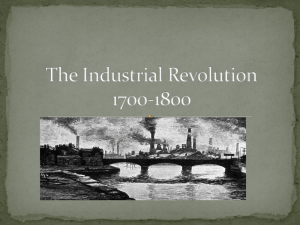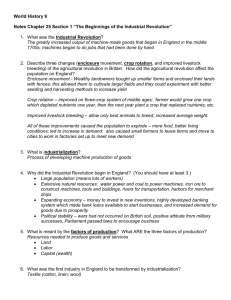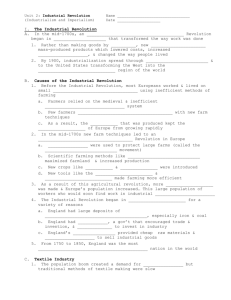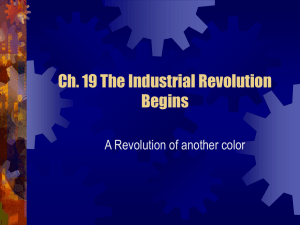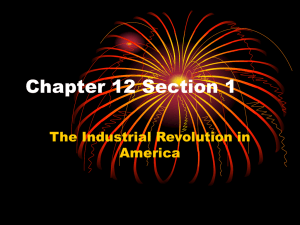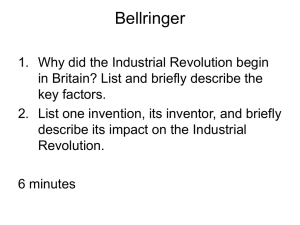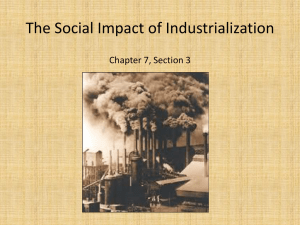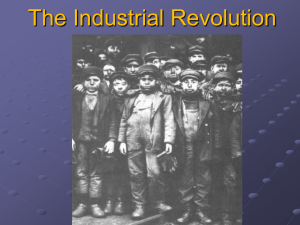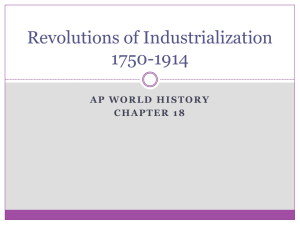Industrial Revolution File
advertisement
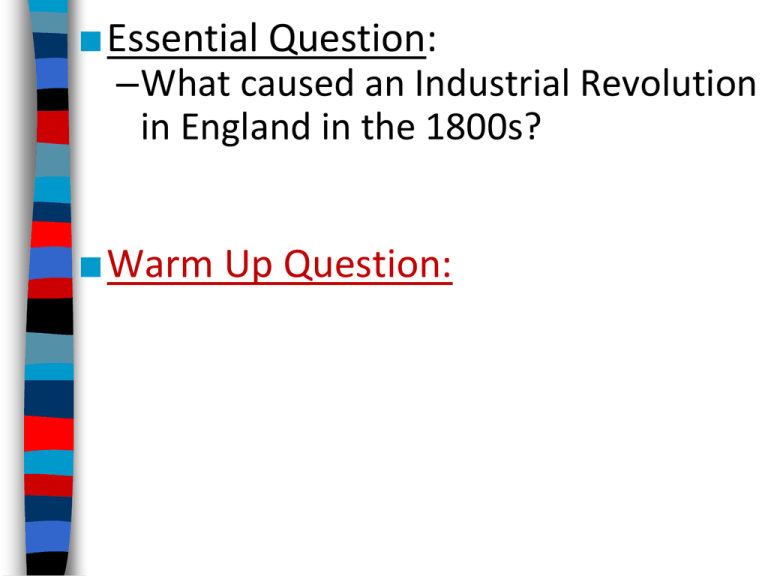
■Essential Question: –What caused an Industrial Revolution in England in the 1800s? ■Warm Up Question: In the mid-1700s, an Industrial Revolution began in England that transformed the way work was done Rather than making goods by hand, new machines mass-produced products which lowered costs, increased profits, & changed the way people lived What caused the Industrial Revolution & why did it begin in England? By 1900, industrialization spread through Europe & to the United States transforming the West into the dominant region of the world What was life like before the Industrial Revolution? Before the Industrial Revolution, most Europeans worked & lived on small farming villages using inefficient methods of farming Farmers relied on the medieval & inefficient three-field system Few farmers experimented with new farm techniques As a result, the food that was produced kept the population of Europe from growing rapidly In the mid-1700s new farm techniques led to an Agricultural Revolution in Europe Fences were used to protect large farms (called the enclosure movement) Scientific farming methods like crop rotation maximized farmland & increased production New crops like corn & potatoes were introduced New tools like the iron plow & seed drill made farming more efficient As a result of this agricultural revolution, more food was made & Europe’s population increased… …This large population of workers who would soon find work in industrial factories The Industrial Revolution began in England for a variety of reasons England had large deposits of natural resources, especially iron & coal England had banks, a gov’t that encouraged trade & invention, & money to invest in industry England’s colonies provided cheap raw materials & markets to sell industrial goods From 1750 to 1850, England was the most industrialized nation in the world What was the first industry to industrialize? The population boom created a demand for clothing but traditional methods of textile making were slow As a result, the textile industry became the first to become industrialized What do these inventions do? SpinWeave yarn yarn into cloth Sewing machine New inventions sped up spinning, weaving, sewing European demand for What do these inventions do? cotton led to a boom in cotton production and slavery in the southern United States Cotton gin Eli Whitney’s invention of the cotton gin stimulated a demand for cotton textiles New textile machinery led to the factory system Factory owners made Power-driven machines huge profits selling were able to mass-produce mass-produced clothes goods very fast & cheap The textile industry & the rise of the factory system led to the growth of other industries Factories needed power & were usually located near rivers In 1765, James Watt invented the first steam engine Steam engines produced more power & allowed factories to be built in cities near workers The textile industry & the rise of the factory system led to the growth of other industries Factories led to a demand for faster transpiration Roads & canals were built in England; Robert Fulton’s steamboat increased the speed of water travel The greatest improvement to transportation was the steam-powered railroad RRs were fast, increased profits, & stimulated the iron & coal industries Growth of Railroads, 1850-1880 The textile industry & the rise of the factory system led to the growth of other industries The Industrial Revolution led to an increase in coal to power factories & RRs Iron was needed to produce new machines, engines, & railroad track By 1800, England made more iron than all other nations in the world combined The textile industry & the rise of the factory system led to the growth of other industries Henry Bessemer invented a cheap process for making steel which is stronger than iron Steel allowed engineers to design more powerful machines, taller buildings, & longer bridges Other inventions of the Industrial Revolution include electricity, new forms of communication such as the telegraph & telephone, business machines like typewriters & cash registers, and medical improvements like vaccines The Industrial Revolution soon spread throughout Europe & America Germany was quick to embrace new industrial technologies Germany had large supplies of coal & iron ore Germans built a large network of railroads, iron & textile factories By the mid 1800s, Germany was one of the world’s industrial leaders & built a powerful modern militaries The Industrial Revolution soon spread throughout Europe & America Southern cotton led to textile mills in the North After the Civil War in 1865, American industry boomed & the United States became a world leader in railroads, oil, steel, electricity Many U.S. companies merged to form large corporations & monopolies Industrial ideas turned the United States into an important world power Conclusions: From 1700 to 1900, revolutions in agriculture, industry, transportation, & communication changed Western Europe and the United States Industrialization gave Europe tremendous economic & military power Industry also had numerous negative effects on working conditions & the standard of living for urban workers

